2009: An Astounding Evening
Shankar Iyer | burmanfan@gmail.com
Yeshwant Natya Mandir, Matunga stood testimony in 2009 an astounding evening on 15th February – The celebration of two legendary musical stalwarts – Sitar maestro Jairam Acharya and versatile champion percussionist Burjor Lord. The occasion stamped organizing group Swar Aalap’s passionate and unfailing dedication to the cause of Hindi film musicians.
Shankar Iyer encapsulates the event’s magnetic appeal that had the audience in rapt attention. “Tradition met Improvisation’ with the on-stage performances of veteran Sitar player Jairam Acharya and multi-instrumentalist Burjor Lord. The idea was to showcase the work of these two great behind-the-scene musicians to music lovers.
Pt. Ravishankar taught me the techniques:
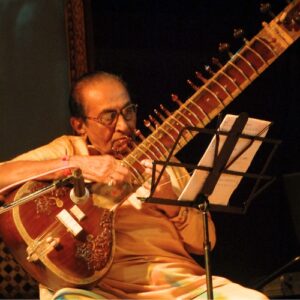 As the evening’s first guest Jairam Acharya was escorted to stage by Swar Aalap patron Arun Puranik, a small video helped to familiarize the audience with the Sitarist’s huge work. Sharing facts on the evolution of his Sitar playing style, Jairamji explained “I learnt to play the Sitar from my father. Apart from that, well-known Sitar player Pandit Ravishankar used to come to HMV, he agreed, he observed my style of Sitar playing and taught me the technique of fingers, placement of right hand correctly while playing the Sitar. I remember I had even purchased a Philips tape-recorder to listen to other instrument players and how they tuned their instruments. I also used it immensely to improve my own quality of playing. Also, slowly I was learning music notations that later went a long way to make things easy for me as a musician”.
As the evening’s first guest Jairam Acharya was escorted to stage by Swar Aalap patron Arun Puranik, a small video helped to familiarize the audience with the Sitarist’s huge work. Sharing facts on the evolution of his Sitar playing style, Jairamji explained “I learnt to play the Sitar from my father. Apart from that, well-known Sitar player Pandit Ravishankar used to come to HMV, he agreed, he observed my style of Sitar playing and taught me the technique of fingers, placement of right hand correctly while playing the Sitar. I remember I had even purchased a Philips tape-recorder to listen to other instrument players and how they tuned their instruments. I also used it immensely to improve my own quality of playing. Also, slowly I was learning music notations that later went a long way to make things easy for me as a musician”.
The orchestra’s first song “Aankhon hi ankhon mein ishara ho gaya” (CID, OP Nayyar) set the mood for the evening with Jairam Acharya’s unforgettable Sitar pieces. When being asked to comment on the difference between Classical Sitar playing and film Sitar playing, Jairamji remarked “Classical Sitar playing involves playing on one’s own, at times even improvising on the Raga. In film music, however, you have to play the music director’s piece. It is his conception that originates from the song situation. Musicians have to play as per the music director’s compositions”.
During the event, Jairamji fondly recalled “I enjoyed playing for all music directors viz. S D Burman, OP Nayyar, C Ramchandra, Shankar-Jaikishan, Madan-Mohan, Roshan, Hemant Kumar, Khaiyyam, Vasant Desai, S N Tripathi, Chitragupta, Kalyanji-Anandji, R D Burman, and Laxmikant-Pyarelal from 1946 to 1995. I started with HMV in 1946 and learnt many things while playing for the music directors.
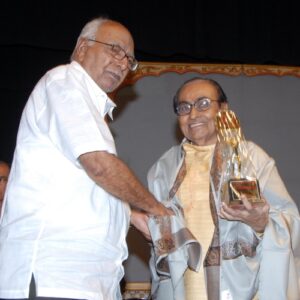 C Ramchandra was very sincere:
C Ramchandra was very sincere:
Anna (C Ramchandra) used to call me ‘Acharya saheb’. He once asked me to compose a 16-baar music piece. When I had made it, he openly appreciated my effort before all other musicians. Such was his sincerity.” Some more trivia about music composers followed “Shankar-Jaikishan’s ‘Bhairavi’ raga was a trademark. Dada Burman never relied on any messenger and personally ensured to call me.
As the orchestra moved ahead, songs like “Kaali ghata chhaye mora jiya tarsaaye” (Sujata, S D Burman), “Piya aiso jiya mein” (Sahib Bibi Aur Ghulam, Hemant Kumar) and “Saari saari raat teri yaad sataye” (Aji Bas Shukriya, Roshan) only added more weight and meaning to Jairam Acharya’s vast range and ability as a Sitar player.
Colleague Sais:
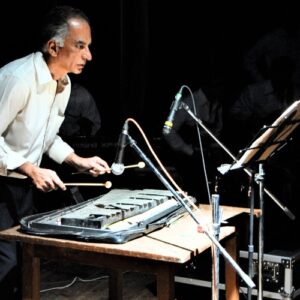 Renowned Sarod player Zarine Daruwala expressed “Pandit Jairam Acharya will remain very special for me. All must learn how a senior artiste needs to treat a junior artiste from Jairamji. Another short but sweet tribute came from eminent arranger and multi-faceted instrumentalist Kersi Lord. I know Jairam Acharya from 1948. One must remember that thanks to musicians like Jairam Acharya. He learnt to play on music notations, later, the earlier 5-6 rehearsals for a song reduced to 2-3 rehearsal sessions”.
Renowned Sarod player Zarine Daruwala expressed “Pandit Jairam Acharya will remain very special for me. All must learn how a senior artiste needs to treat a junior artiste from Jairamji. Another short but sweet tribute came from eminent arranger and multi-faceted instrumentalist Kersi Lord. I know Jairam Acharya from 1948. One must remember that thanks to musicians like Jairam Acharya. He learnt to play on music notations, later, the earlier 5-6 rehearsals for a song reduced to 2-3 rehearsal sessions”.
Reminisced veteran Mandolin and Sarod player Kishore Desai “We started to work together with ‘Basant Bahar’ (Shankar-Jaikishan). He was a Sitar expert and people often remember him for his Sitar pieces has been used a lot in films and song situations” In the interim, the orchestra song sequence of “Jyoti kalash chhalke” (Bhabhi Ki Chudiyan, Sudhir Phadke) and “O sajana barkha bahaar aayi” (Parakh, Salil Chowdhury) with Jairamji playing live on stage kept the program’s velvety flow going.
The first session of the fascinating evening concluded with the shawl and trophy felicitations of Jairam Acharya was done by distinguished poet and lyricist Shri Naqsh Lyallpuri. Perhaps, the larger icing on the cake was the presence of yesteryear actress Kamini Kaushal in her distinct attractive sweet voice, she remembered “It is lovely to be here today, to witness those people who put life to our screen performance.
Playing in almost 15000 Hindi film songs:
The curtains re-opened with the 2nd guest of the evening Burjor Lord taking centre stage. Son of yesteryear stalwart percussionist Cawas Lord, Burjor (Buji) Lord has been one of the sought-after percussionists of the golden era. Playing in almost 15000 Hindi film songs, Buji Lord has been an expert exponent of instruments like the Drums, Vibraphone, Xylophone, Glockenspiel and Bonga. He has also played other percussion instruments like the Conga, Tumba, Ghunghroo and Wood Blocks.
Sharing his thoughts in his unique humorous style, Buji Lord made an immediate impact at the beginning. Acknowledging Swar Aalap’s work and dedication he admitted “Hindi cinema has included even the hair-stylist name in the titles, but never acknowledged the work of the film musicians. But Swar Aalap is now working for this cause.”
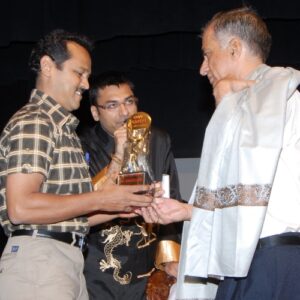 Viewers were certainly delighted:
Viewers were certainly delighted:
The show began by introducing the first of Buji Lord’s key instruments, the Vibraphone. A mallet instrument has thin bars on one side and thick bars on the other. There are resonance pipes below; there is also a motor for variable speed which gives the back vibrations. There are soft and hard mallets used depending on the type and mood of the song. It adds a very definitive but subtle flavor to a song.
The songs “Kuchh dil ne kaha” (Anupama, Hemant Kumar), “Mujhe Jaan Na Kaho Meri jaan” (Anubhav, Kanu Roy) and “Chhupa lo yoon dil mein” (Mamta, Roshan) and “Main toh ek khwab hoon” (Himalay Ki God Mein, Kalyanji-Anandji) set the ball rolling. It was sheer magic to hear and experience Buji Lord’s live playing. It was almost unbelievable that the artiste was performing on stage after a gap of almost 25 years! And the viewers were certainly delighted; for it was not only the Vibraphone, but also the Glockenspiel, Xylophone and the drums that were to follow!
Speaking of the difference of his playing style to his brother Kersi Lord’s, Buji Lord said “Both had a unique style. Kersi and I were the 2 players for Western Classical and Jazz-based type of songs, there were many other Vibraphone players like Shamrao Kamble, Arun Mohile, Arun Paudwal, Salim and Farokh for the Indian-based songs.”
Moving on to the next instrument Glockenspiel, viewers were informed of the instrument’s German origin. It is with the bars being thinner and smaller with no resonance pipes or motor attached. Not always clearly heard in Hindi film songs due to recording technique limitations, songs like “Main zindagi ka saath nibhaata chala gaya” (Hum Dono, Jaidev, played by Kersi Lord), “Rahein na rahein” (Mamta, Roshan) and “Jo vaada kiya wo” (Taj Mahal, Roshan) have helped to make this instrument popular.
Another similar mallet instrument is the Xylophone. Very similar to the Vibraphone in appearance, the bars are made of wood and there is no motor or pedal. The Xylophone is played with soft, medium or hard mallets by striking the bars. The technique of playing is similar for both instruments. A popular song as an example – “Sayonara, sayonara” (Love in Tokyo, Shankar- Jaikishan)
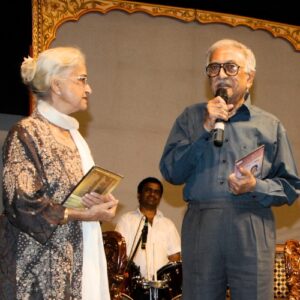 Ameen Sayani perfectly said:
Ameen Sayani perfectly said:
Rightly enough, Swar Aalap chose to present Buji Lord’s extensive musical repertoire. I was with the help of brief but captivating video footages of the original songs. Some more orchestra performance followed to list Buji Lord’s unlimited talent. “Jab chali thandi hawa” (Do Badan, Ravi, Bonga), “Ek haseen sham ko” (Dulhan Ek Raat Ki, Madan Mohan, Wood Blocks), Mehbooba Mehbooba (Sholay) and Jaane-jaan dhoondta (Jawani Diwani, RD Burman, Drums with live playing again!). It was an apt grand finale as all rose to the occasion of the touching “Aye mere watan ke logon”. The C Ramchandra composition was tuned to the soothing notes of the Timpani played by Buji Lord. In the end, for us mere mortals, a couplet by India’s beloved Radio voice Ameen Sayani perfectly summed up the evening party.
Aye bade badon, kaam barabar baanta jaye, Aye bade badon, kaam barabar baanta jaaye, Aap pakayein, banda khaye!
The concept was well executed as were the video compilations, ably supported by VIP Industries, S.Kumars, Shemaroo, Rustomji Kothari, Goli Vada Paav and Furtados. We can’t but help ask for more and more!!!!


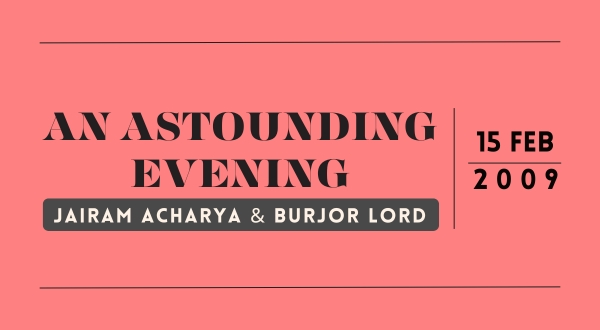
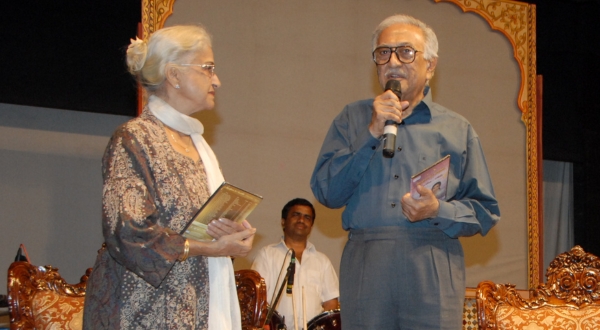
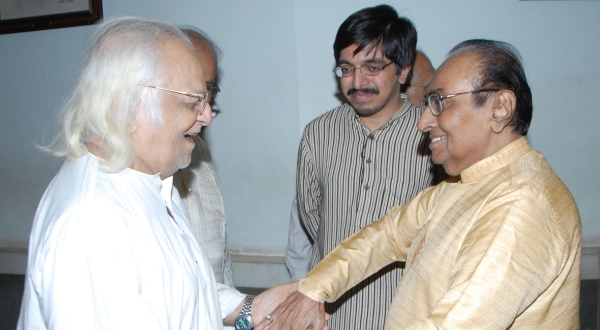
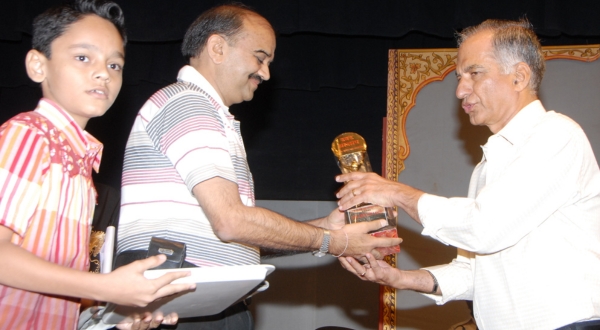
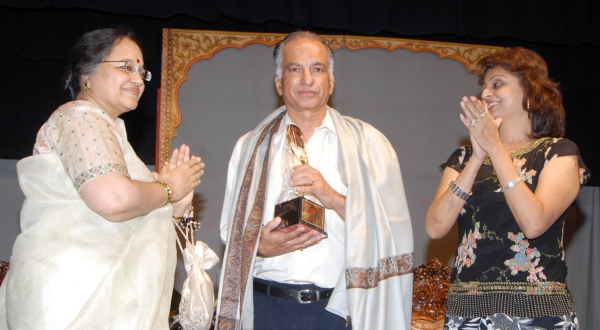
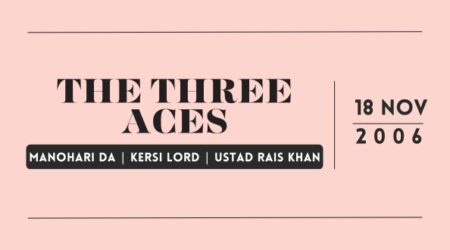
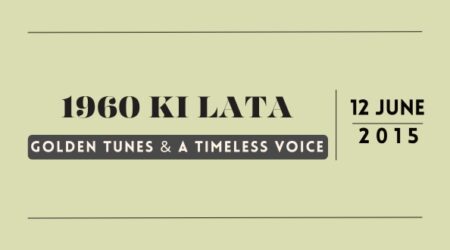

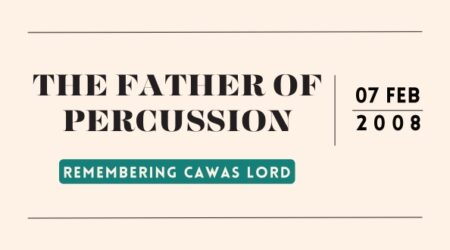
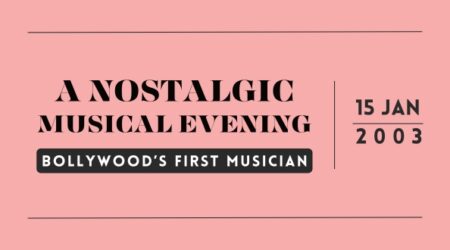
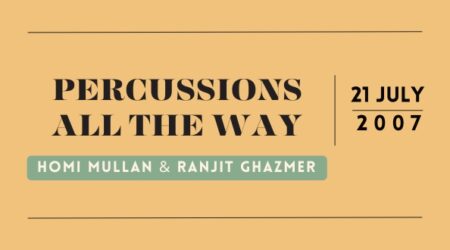

Leave a Reply